
by jhwildlife | Jun 1, 2017 | Blog, Nature Mapping Jackson Hole
 Last month, JHWF’s Executive and Associate Directors attended the biannual meeting of the Citizen Science Association (CSA) in St. Paul, MN. The CSA aims to bring together the expertise of diverse practitioners working in the field of citizen science, to share the breadth of resources and best practices found throughout the field. Only a few years old, CSA’s membership already exceeds 4,000 individuals from over 80 countries. Indeed, there was a welcomed international contingent in attendance at this gathering of “citsci folks” – Brazil, New Zealand, England, Canada, Australia and Kenya, to name a few.
Last month, JHWF’s Executive and Associate Directors attended the biannual meeting of the Citizen Science Association (CSA) in St. Paul, MN. The CSA aims to bring together the expertise of diverse practitioners working in the field of citizen science, to share the breadth of resources and best practices found throughout the field. Only a few years old, CSA’s membership already exceeds 4,000 individuals from over 80 countries. Indeed, there was a welcomed international contingent in attendance at this gathering of “citsci folks” – Brazil, New Zealand, England, Canada, Australia and Kenya, to name a few.
We came home with our heads full of ideas for our very own Nature Mapping Jackson Hole program, which is a super example of citizen science in action. Conversations at the conference covered many critical areas, such as: the need for fostering community amongst citizen science professionals, a sense of creating a mandate around using well-vetted knowledge to make a difference, advancing the role of public citizens in conducting and defining research, and most of all, fostering and strengthening partnerships across the board.
Best of all, we came back from this conference with a reconfirmation of the value and specialness that is Nature Mapping Jackson Hole. Within the past nine years, 435 people have been trained as certified Nature Mappers and have entered 45,345 observations into the program’s central database. All this effort is filling wildlife observation and distribution needs not already covered by state and federal agencies or local research organizations. Furthermore, together we are fostering a community that looks deeper into the meanings of science and citizenship – therefore, realizing that to participate in the building of knowledge about how our world works, can have profound implications for the way we, Jackson Hole, relate to our natural environment and shape its future.
Thank you for getting involved in the experiences of seeing, feeling, and understanding nature in all its amazingness through Nature Mapping Jackson Hole. Keep up the great work, it’s making a difference!
The whole of science, and one is tempted to think the whole of the life of any thinking man, is trying to come to terms with the relationship between yourself and the natural world. Why are you here, and how do you fit in, and what’s it all about?
– Sir David Attenborough
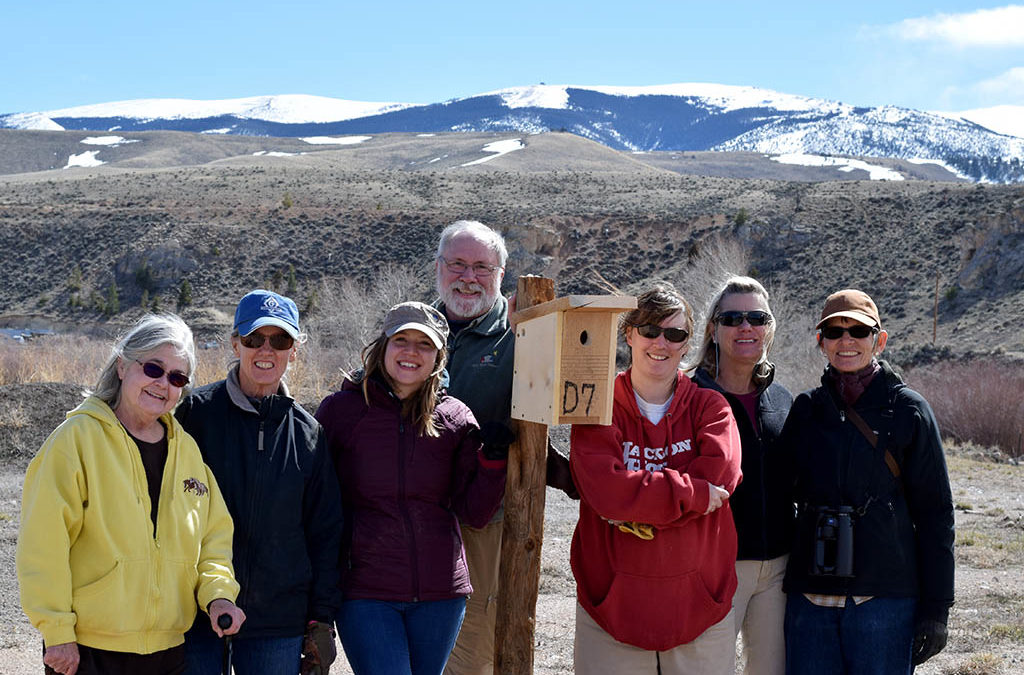
by jhwildlife | Apr 19, 2017 | Blog, Nature Mapping Jackson Hole
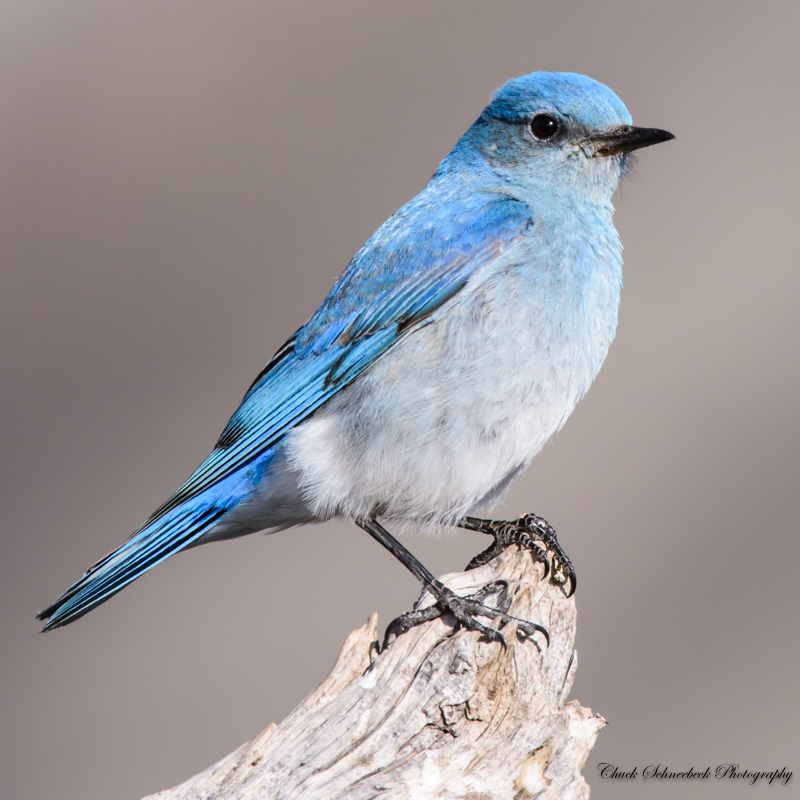
Photo by Chuck Schneebeck
“O bluebird, welcome back again.
Thy azure coat and ruddy vest,
Are hues that April loveth best.”
– John Burroughs
The great writer and conservationist John Burroughs shared his love of the Eastern Bluebird brilliantly, with words that express abiding affection for the “bluebird of happiness.” The resident of our parts, the Mountain Bluebird, has no shortage of admirers uplifted by that bright blue flash across the landscape. Here we are in April, and the Mountain Bluebirds have returned! We see them flitting from post to post along the National Elk Refuge fence, and spiriting their way across the grassy meadows of South Park. After a long winter, could there be a more hopeful harbinger?
At the Jackson Hole Wildlife Foundation, we have the honor of continuing a Mountain Bluebird monitoring program that Chuck and Carol Schneebeck and friends launched more than a decade ago. With the help of dozens of volunteers over the years, we have tracked the number of boxes utilized and by which species, the number of eggs laid, the number of nestlings fledged, and other valuable data to help us understand the lives of bluebirds.
While that data and our growing knowledge of the bluebird is important, perhaps the real power of the program lies in its affect on the people who participate. For anyone who has peered into a box to find a fresh egg or a newly hatched featherless bird, there is no mistaking the thrill of the experience. It can be hard to contain the joyful feeling that John Burroughs described – nearly always shared with others. As we continue to monitor the success of the Mountain Bluebird Nestbox trail along the National Elk Refuge, we’re also exploring ways to share what we’ve experienced with others in neighboring communities. In early April, we had the pleasure of working with a committed group of bluebird enthusiasts in Dubois to install 35 boxes to create the Dubois Community Bluebird Trail. Our super volunteer and bluebird trail expert Tim Griffith provided a trail monitoring orientation to the group at the Dubois Museum. Associate Director Kate Gersh spoke about the success of the nestbox trail in Jackson and why Jackson Hole Wildlife Foundation is interested in partnering with Dubois in a similar effort.
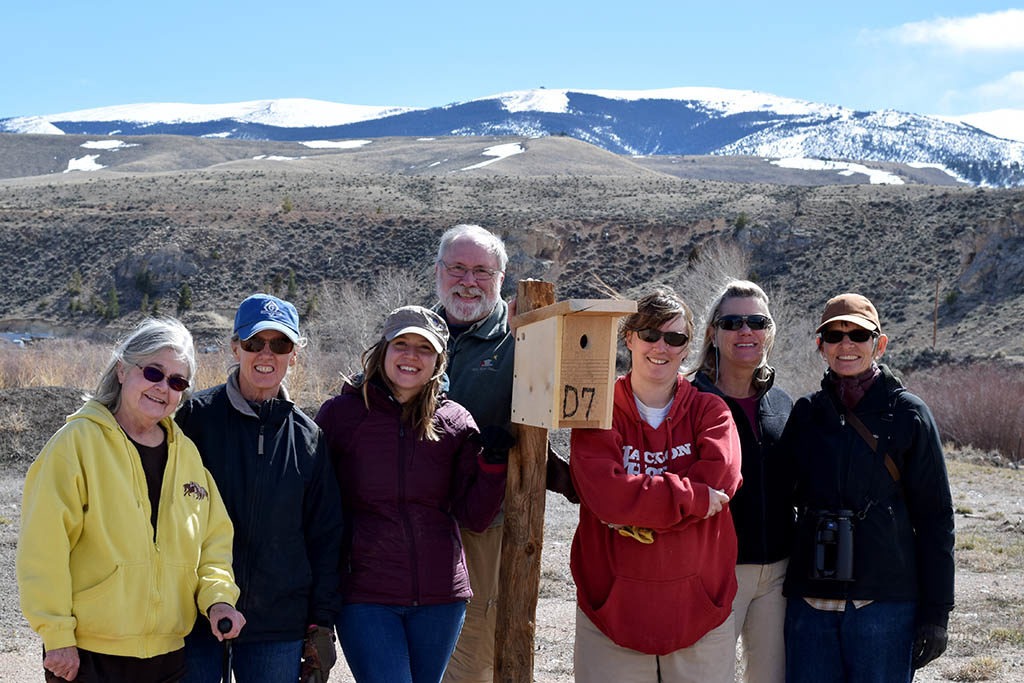
Andrea, Deb, Kate, Tim, Johanna, Bridget and Susan install a box at the Warm Valley Lodge assisted living center in Dubois.
As Aldo Leopold famously said, “a land ethic … evolves in the minds of a thinking community.” Leopold recognized that such an ethic might emerge in the individual first through observation, and the recording of what one has observed. Through this process, one becomes more aware of what is going on around them. Combining individual observations in a community monitoring program brings people together around a shared appreciation for wildlife. Our hope is that bringing communities together to share their observations and interactions will build stronger connections between stewards of Greater Yellowstone lands. Who better than the bluebird to act as that joyful ambassador?

Lead project coordinator Johanna Thompson of the Dubois Museum & Wind River Historical Center makes a Dubois box “official.”
The Mountain Bluebird Nestbox Trail monitoring effort is one of many projects of Nature Mapping Jackson Hole. Each project is designed to increase our local knowledge of many species while advancing our community’s land ethic. Expanding the boundaries of that community might help ensure that our area’s ecosystem is preserved and protected in perpetuity, joining people and lands around common values.
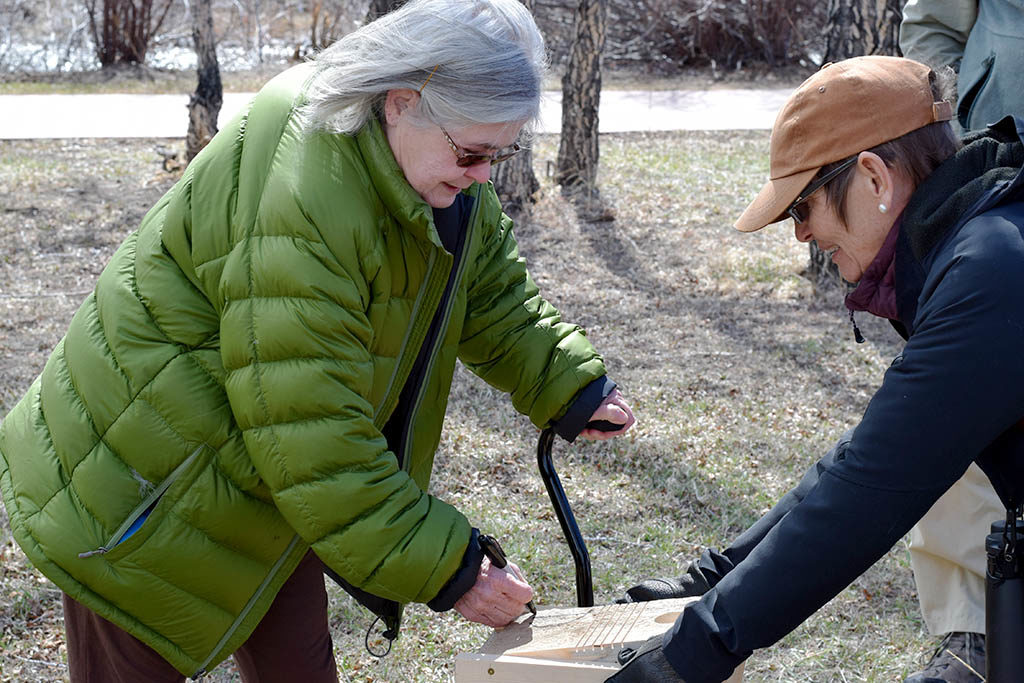
Key volunteer Andrea Billingsley inscribes “D1” on the first box of the Dubois Community Bluebird Trail while Susan Hill supports and celebrates.
View a full gallery of fun images from “Bluebird Day” in Dubois.
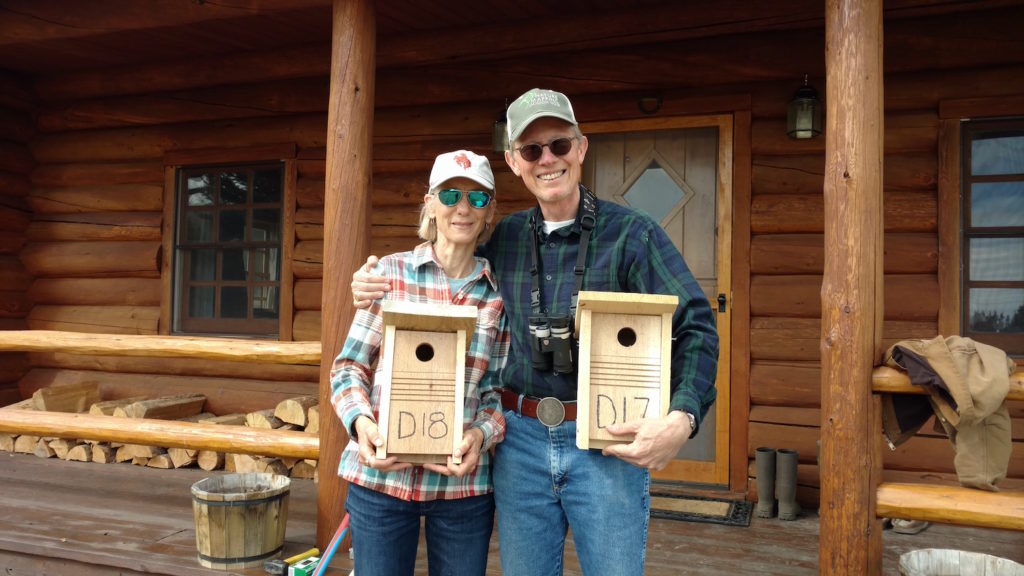
Nancy and Blair Butterfield prepare to install two boxes on their Dubois property with assistance from Jackson Hole Wildlife Foundation staff.

by jhwildlife | Mar 7, 2017 | Blog, Nature Mapping Jackson Hole
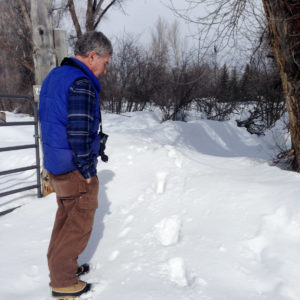
Earle Layser spots moose tracks in West Jackson
Moose Day 2017 set a record for community participation and for the number of moose counted. We extend our thanks to the Nature Mappers and new recruits as well as, biologists from Wyoming Game & Fish Department, Grand Teton National Park and U.S. Forest Service. All volunteered their time from 7 a.m. to 12 noon on Saturday, February 25.
This year, a total of 33 teams, comprising 83 volunteers counted 166 moose, contributing over 290 hours time.
This exceeds our previous record of 124 moose in 2011, and the 99 moose seen last year. Volunteer numbers are well over our 65 person average. In 2016, we had 73 participants helping with the count. This was our 9th annual Moose Day.
Volunteers snowmobiled, snowshoed, drove, walked and most of all, climbed up snow banks to scout moose! Many were rewarded by seeing moose — in some cases many! Successful surveyors often had local tips or tracked fresh moose sign to find hidden individuals. In other cases, neighborhood teams were disappointed to not see the moose that was “there yesterday” and saw no moose at all. However, zero (0) moose is important data as well. And, it is clear that moose move!
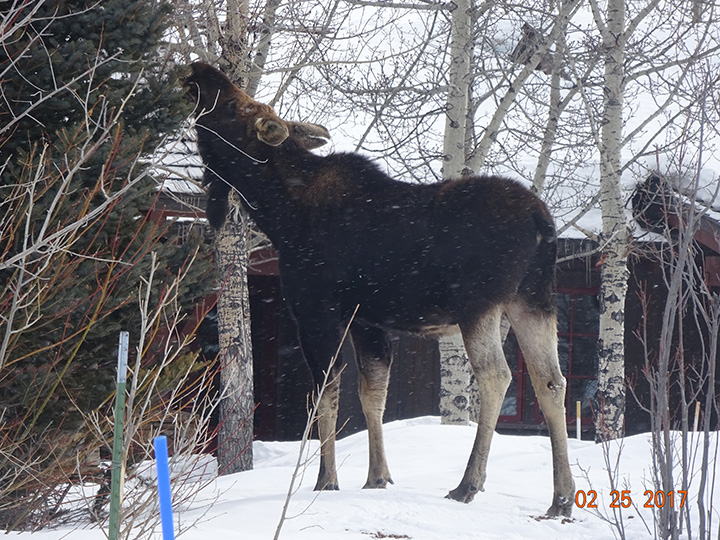
A moose feeding by Randy Reedy
Where were the moose this year? It appears they were attracted to low-lying willow wetlands, such as Buffalo Fork Valley, along the Gros Ventre River and in Wilson. For instance, Kerry Murphy and his U.S. Forest Service team were able to survey the Gros Ventre all the way east to Darwin Ranch. Along this route, often with extensive willow stands, they surveyed 57 moose! Much closer to civilization, moose were seen browsing on exotic shrubs in Jackson or loafing in the shelter of buildings. In a few spots, moose were even congregating close to horses.
Where were moose missing? Often in areas of extremely deep snow, such as the northern stretches of Grand Teton National Park and at the base of the mountains along Fish and Fall Creek Roads. Other wide open areas had little browse for the amount of effort it would take to reach it. Fortunately, most reports indicate moose were in good condition.

Other critters like Bald Eagles were mapped, too. Photo by Alice Cornell
Whether Nature Mappers saw moose or not, they reported a good time. Many observed (and mapped) other critters as well: wolf, coyote, Trumpeter Swans, otter, beaver, Bald Eagles, elk, Red Crossbills, a dipper and other birds. Teams of friends and strangers enjoyed each other’s company for the morning, and over 30 volunteers showed up at E.Leaven for lunch to share their stories. Moose Day is very much a community event!

30 moose mappers recounting the morning’s count at E. Leaven. Photo by Frances Clark
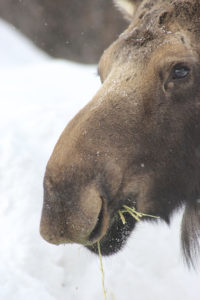
Moose munching by Mary Lohuis
Moose Day is important because we survey moose on private lands, where public-land biologists rarely go. We thank the Snake River Ranch, Snake River Sporting Club, Jackson Holf Golf & Tennis, and Trail Creek Ranch as well as, homeowner associations and individuals for granting permission for us to survey their private property. Without their support we would not have counted so many moose!
Next, Paul Hood and Aly Courtemanch will analyze the data and produce a formal 2017 Moose Day report. This report will enable biologists to determine trends in moose populations and planners to understand where moose roam and rest.
Again, many many thanks to the Nature Mapping Jackson Hole community for caring about our Teton County moose!
Frances Clark
Moose Day Coordinator
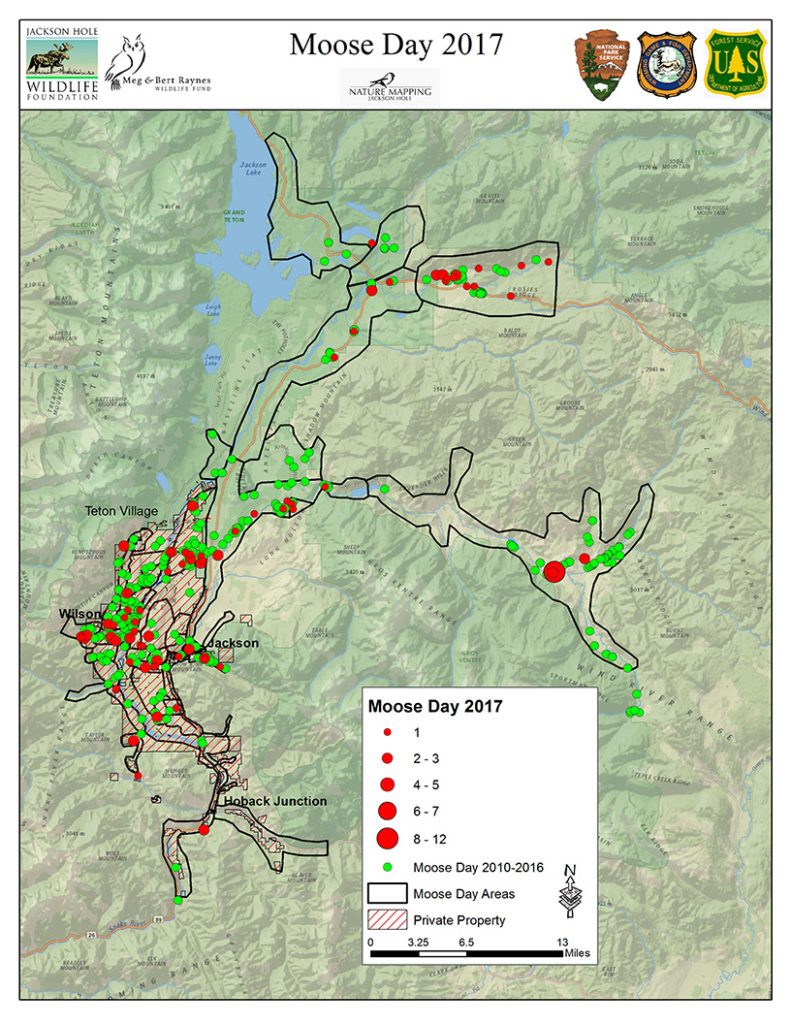
Note: Moose By The River photo by Alice Cornell
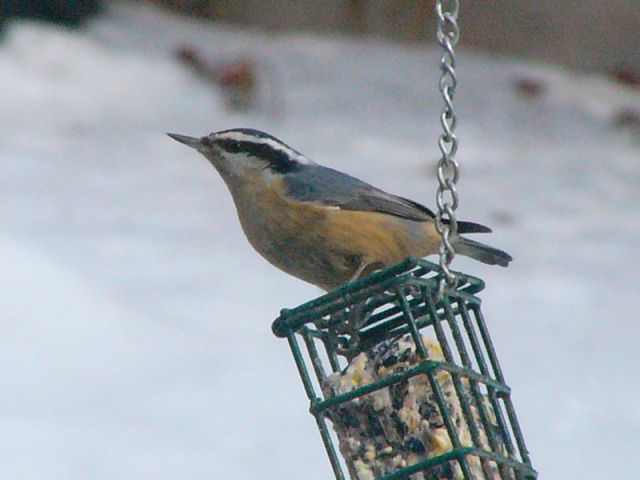
by jhwildlife | Feb 27, 2017 | Blog, Nature Mapping Jackson Hole
by Susan Marsh
When Nature Mapping Jackson Hole began in 2009, Project Backyard (PBY) was born. It was the first systematic observation protocol developed for Nature Mapping Jackson Hole, meant to augment the casual observations that people recorded while driving or wandering along the mountain trails. What’s the difference between PBY and casual observations, and why does it matter?
A good example may be taken from our first attempt at counting moose on a single day for Nature Mapping Jackson Hole, prior to the start of the organized Moose Day, for which observers are assigned specific areas. On that first count we had lots of observations, but many of them turned out to be the same dozen moose in the Antelope Flats area. It became clear that casual observations could only give so much accuracy on a single day.
What was the best way to achieve a more systematic approach that would be easy for people to work with? Asking homeowners to record what they saw from their backyards seemed like the answer.
Participants in PBY make weekly observations, recording the maximum number of each species seen during a single week. No need to use a GPS unit – anyone participating in the project enters the coordinates for their location once, and they come up automatically each time. You can do it less frequently than weekly, and you don’t have to sit watching the bird feeder all day – just note what you see.

The response has been remarkable. Over 19,140 observations have been made in Project Backyard. These observations are particularly valuable as they provide information about the wildlife living in, or moving through, our neighborhoods and agricultural lands. While the federal agencies and Wyoming Game & Fish Department conduct wildlife counts on public land, they are often geared toward particular species, such as the classification count each February on the National Elk Refuge. Private lands are not included in agency counts since access is not always granted. But if you live there, you can provide valuable insights. It is through private citizen observations that we know about where small elk herds are moving as they increasingly stay the winter in the Wilson area and elsewhere on the valley floor – especially in this high-snow year. It is through citizen observations that we know the winter of 2016-2017 has been a low year for many species of songbirds that are often seen in higher numbers at feeders.
We collect this information not just for our edification. Nature Mapping Jackson Hole receives requests from the county, environmental consulting companies, researchers, non-governmental organizations and land developers, asking for information about what wildlife species might be affected by upcoming plans. Any data that a private firm or individual receives also go to the Teton County Planning & Development Department. Our data help make good decisions for wildlife in the valley.
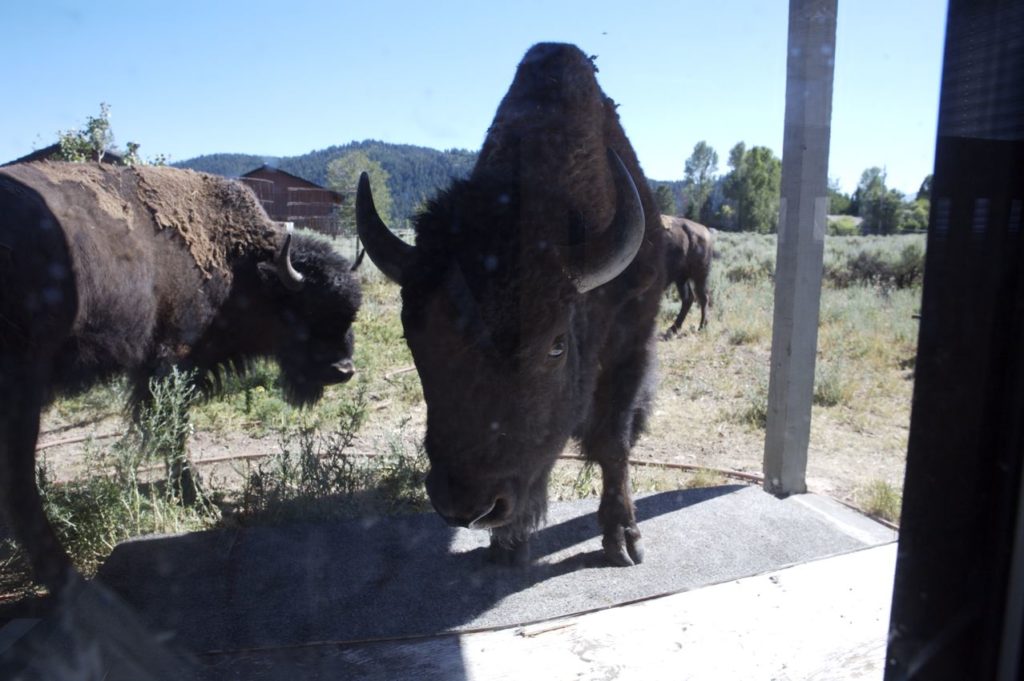
Some PBY observers have been providing information since the inception of the project. Others are welcome additions to the group, adding data from new locations that help give us a broader picture of Teton County wildlife. Many PBY observers are located in a few places — unsurprisingly, those areas where people live: Jackson, Wilson, Rafter J and along WY 22 and HWY 390. Others are located in Alta, Buffalo Valley and scattered from Munger Mountain to Blacktail Butte. It would be wonderful to fill some gaps where observations are not being made, including Moran, Spring Gulch and both Gros Ventre Buttes, the south end of the county, Hoback Junction, Kelly and the Shadow Mountain area. Populations are sparse in some of these spots, so there aren’t many backyards from which to observe. But slowly, we are building a valuable database using citizen science, thanks to the dedication of many people who care about the future of wildlife.
Project Backyard Observers 2013 – 2016:
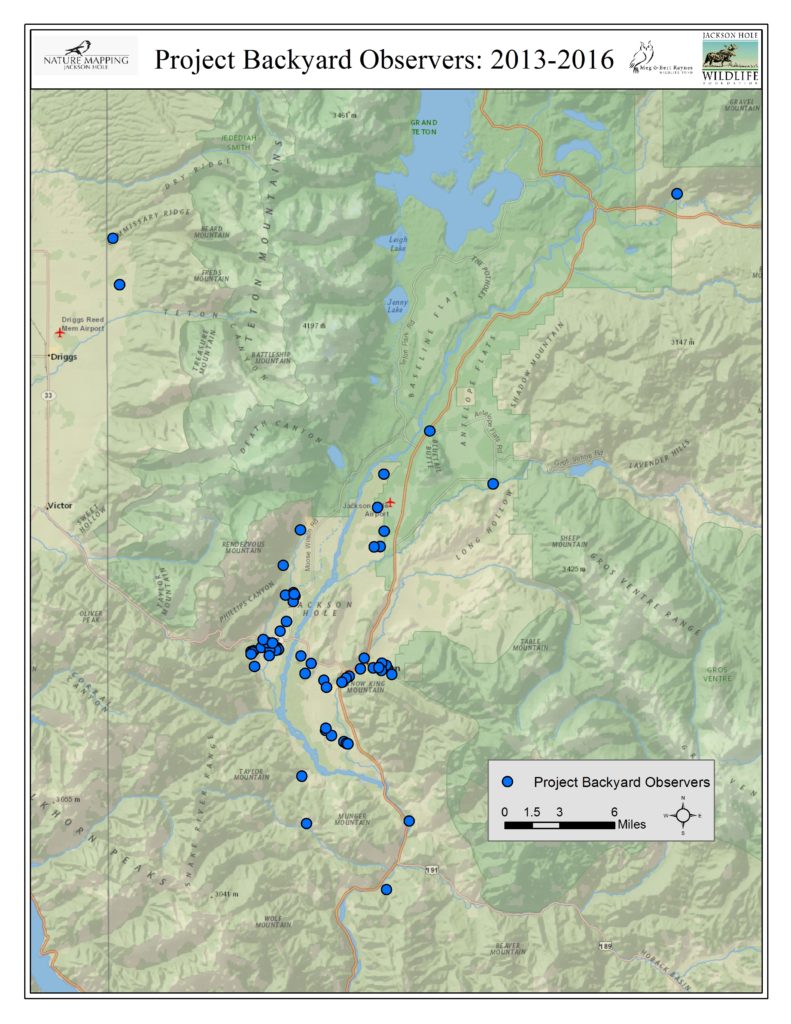
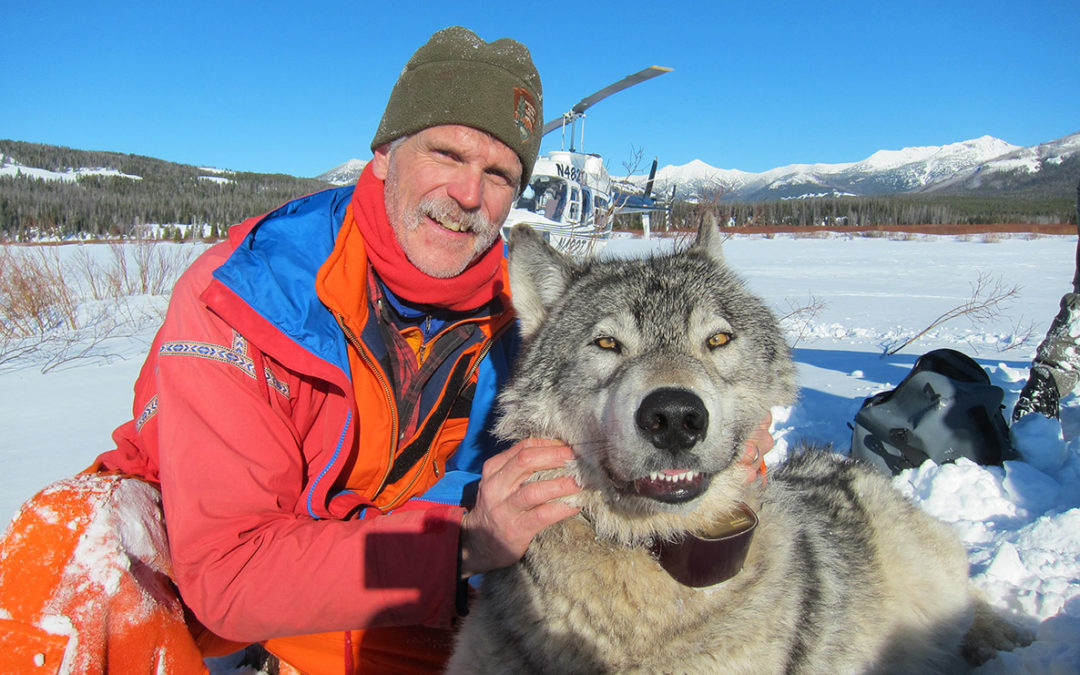
by jhwildlife | Feb 18, 2017 | Blog, Nature Mapping Jackson Hole
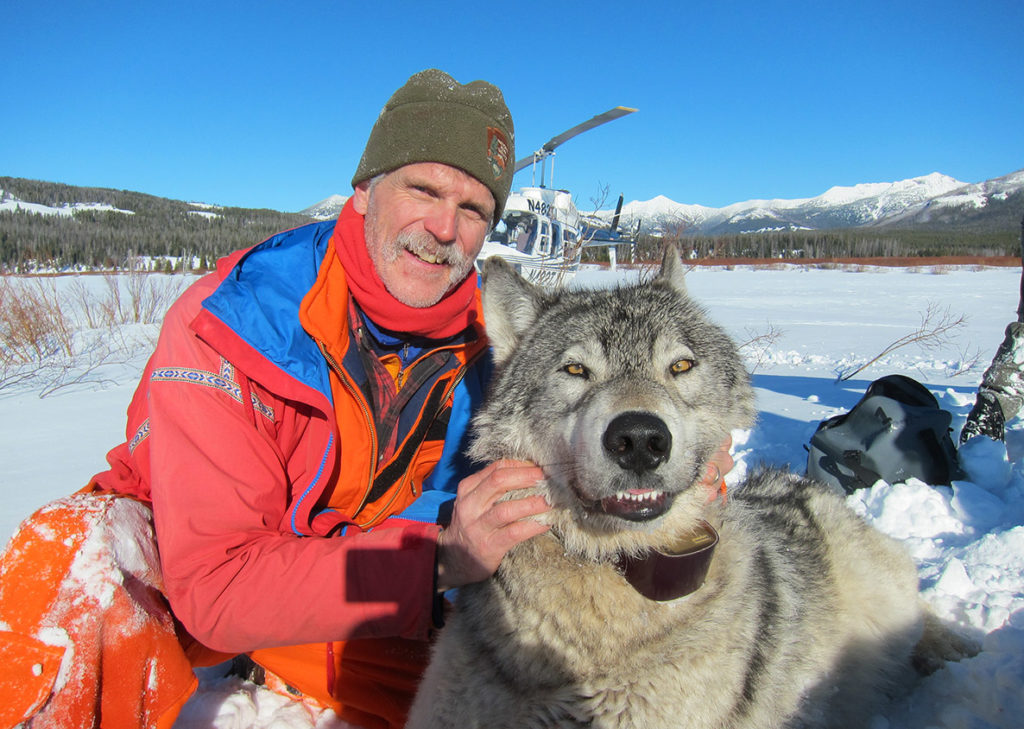
Join us for an annual celebration of our wildlife-friendly community of citizen scientists. The supervisor of the Yellowstone wolf, bird and elk programs Doug Smith will present ‘Yellowstone wolves: the first 20 years’ about wolf population dynamics, wolf-prey relationships, trophic cascades and wolf-human interactions (hunting).
Have some fun and bring a dish to share: Last Name: A-K Main Dish, L-P Side or Salad, Q-Z Dessert
*You are welcome to join us even if you cannot provide a dish
• Nature Mapping Potluck Dinner at 6 pm and Presentation at 7
• At Center for the Arts
• MC: Dawson Smith, Spring Creek Ranch Naturalist Program Director; Jackson Hole Wildlife Foundation Board Member
• March 22, 5:30 pm doors open
• Cost: Free (bring some cash for great raffle items!)
Enter a raffle drawing to win from a selection of great items generously offered by in-kind supporters (tickets are 1 for $5, 5 for $10, 10 for $30).
TIMELINE:
5:30 pm – Doors open
• Raffle items and silent auction on display
• Learn about becoming a Nature Mapper and see what our collective observations reveal in maps that are on display
• Drinks available at cash bar
6 pm – Potluck dinner begins
6:50 pm – Raffle ends
7 pm – Presentation in auditorium features Doug Smith
Thanks to the Meg and Bert Raynes Wildlife Fund and the entire Nature Mapping community for making the evening possible.
SILENT AUCTION ITEMS AND RAFFLE PRIZES:
Silent Auction Items:
• Henry Holdsworth Framed Print of Wolves – Last of the Druids donated by Wild by Nature Gallery
• Breakfast with Eagles Float Trip donated by Jackson Hole Vintage Adventures
• Teton Pines Golfing for Four package donated by Teton Pines Country Club
• Lost Creek Ranch Cookout donated by Lost Creek Ranch
Raffle Prizes:
• Bert Raynes Bird Lovers Package (Special edition of Birds of Sage and Scree, Birds of Jackson Hole, and Far Afield DVD)
• National Park Service Annual Pass & Gift Basket donated by Grand Teton Association
• Spring Creek Ranch – One-Night Stay + Breakfast & Dinner for 2 donated by Spring Creek Ranch
• 2 Day Passes to Jackson Hole Mountain Resort donated by Jackson Hole Mountain Resort
• 5-Pack Yoga Class Card donated by Teton Yoga Shala
• Big R gift card donated by Big R Jackson Hole
• Nature Mapping Jackson Hole Hat and T-shirt

by jhwildlife | Jan 30, 2017 | Blog, Give Wildlife a Brake, Nature Mapping Jackson Hole
Our collective Nature Mapping observations create a long-term dataset of wildlife distribution throughout Jackson Hole. The obvious benefit is that these data provide a more comprehensive view of how wildlife use the valley. The less obvious product of the database is that it includes data that show us how human presence affects wildlife, often in the form of wildlife mortality. The most common reference source for human-caused wildlife mortality is the Jackson Hole Wildlife Foundation’s Wildlife-Vehicle Collision Database. It contains data derived from WYDOT and Wyoming Game & Fish carcass and crash counts, but also includes Nature Mapping observations from citizens who report roadkill to JHWF at 307-739-0968, or enter their roadkill observations directly via their Nature Mapping account. All of these records eventually are cross-checked to remove duplicates. It is an important resource, adding to our local knowledge, and helping to inform county-wide plans to find solutions that save wildlife and make our highways safer for drivers.
The Wildlife-Vehicle Collision (WVC) Database captured 259 collisions in 2015. Data for the 2015 update was acquired from the following data sources: Wyoming Department of Transportation – Carcass (118), Wyoming Department of Transportation – Crash (70), Wyoming Game and Fish Wildlife Observation System (33) and Nature Mapping Jackson Hole (28). In total, the WVC database contains 46 total species with mule deer, white-tailed deer, elk and moose being the most prominent species involved in WVCs.
The below map shows where the most frequent collision points are on the local highway network. The highlighted areas had the highest number of collisions from 2013-2015. During this intense winter of 2016-2017, these data have helped us to pinpoint places to add emergency mitigation measures. If you see a dead animal on the side of the highway – small mammals and rodents as well as ungulates – please enter it into the Nature Mapping database, or call us at 307-739-0968 with precise location and time and our staff will enter it. We are likely underestimating the number of animals struck on the highways – certainly for non-ungulates – and our future solutions will depend on our ability to accurately capture what is happening on the roads. Thank you for your help!
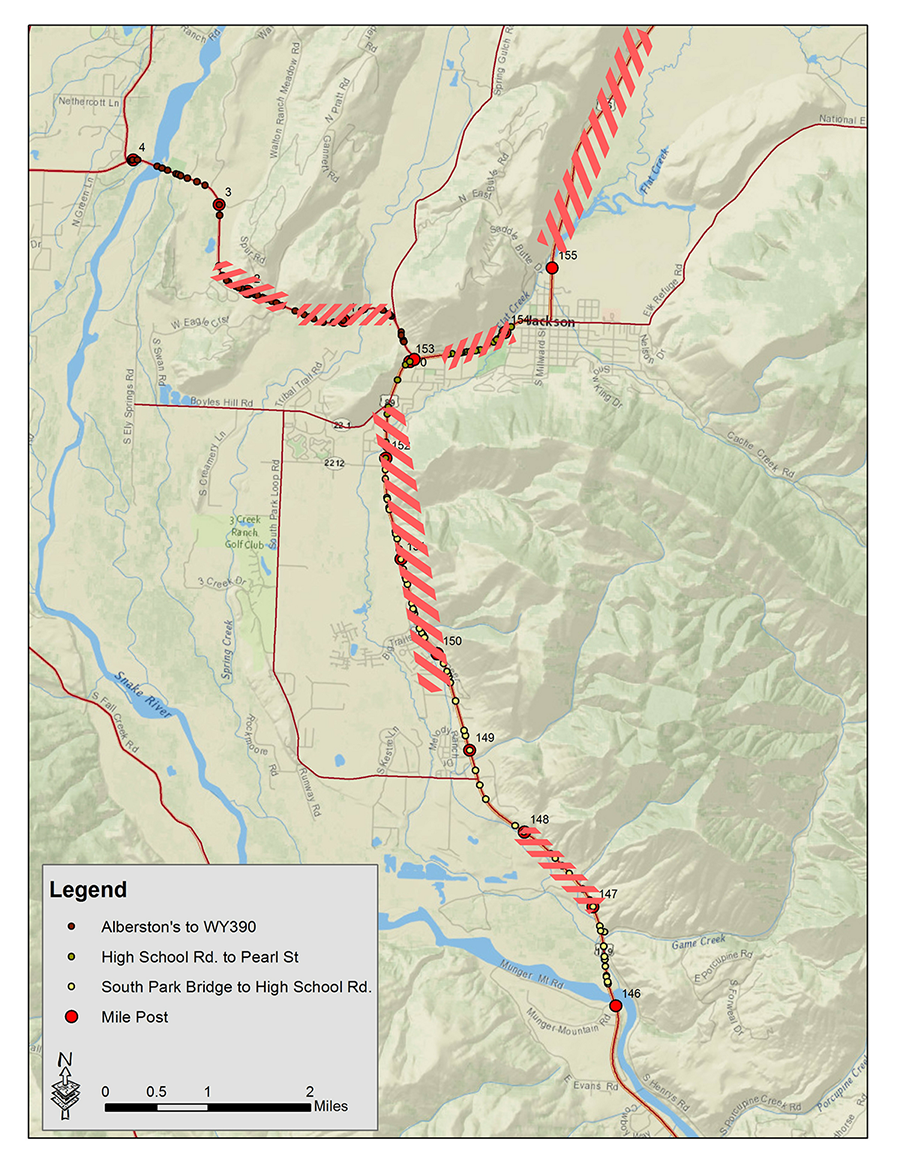

 Last month, JHWF’s Executive and Associate Directors attended the biannual meeting of the Citizen Science Association (CSA) in St. Paul, MN. The CSA aims to bring together the expertise of diverse practitioners working in the field of citizen science, to share the breadth of resources and best practices found throughout the field. Only a few years old, CSA’s membership already exceeds 4,000 individuals from over 80 countries. Indeed, there was a welcomed international contingent in attendance at this gathering of “citsci folks” – Brazil, New Zealand, England, Canada, Australia and Kenya, to name a few.
Last month, JHWF’s Executive and Associate Directors attended the biannual meeting of the Citizen Science Association (CSA) in St. Paul, MN. The CSA aims to bring together the expertise of diverse practitioners working in the field of citizen science, to share the breadth of resources and best practices found throughout the field. Only a few years old, CSA’s membership already exceeds 4,000 individuals from over 80 countries. Indeed, there was a welcomed international contingent in attendance at this gathering of “citsci folks” – Brazil, New Zealand, England, Canada, Australia and Kenya, to name a few.




















